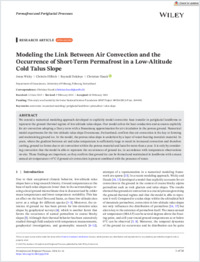Modeling the Link Between Air Convection and the Occurrence of Short-Term Permafrost in a Low-Altitude Cold Talus Slope
DOKPE
- Wicky, Jonas University of Fribourg
- Hilbich, Christin University of Fribourg
- Delaloye, Reynald ORCID University of Fribourg
- Hauck, Christian ORCID University of Fribourg
- 2024
Published in:
- Permafrost and Periglacial Processes. - Chichester, UK : Wiley. - 2024, vol. 35, no. 2, p. 202-217
English
We extend a numerical modeling approach developed to explicitly model convective heat transfer in periglacial landforms to represent the ground thermal regime of low-altitude talus slopes. Our model solves for heat conduction and accounts explicitly for air convection adopting a Darcy term with a Boussinesq approximation for air circulation in the porous ground. Numerical model experiments for the low-altitude talus slope Dreveneuse, Switzerland, confirm that air convection is the key to forming and maintaining ground ice. In the model, the porous talus slope is underlain by a layer of water-bearing morainic material. In years, where the gradient between air and talus temperature is sufficiently large to result in increased convection and therefore cooling, ground ice forms due to air convection within the porous material and lasts for more than a year. It is only by considering convection that the model is able to represent the occurrences of ground ice, in accordance with temperature observations on-site. These findings are important, as they confirm that ground ice can be formed and maintained in landforms with a mean annual air temperature > 0°C if ground air convection is present combined with the presence of water.
- Faculty
- Faculté des sciences et de médecine
- Department
- Département de Géosciences
- Language
-
- English
- Classification
- Earth sciences
- License
- CC BY
- Open access status
- hybrid
- Identifiers
-
- DOI 10.1002/ppp.2224
- ISSN 1045-6740
- ISSN 1099-1530
- Persistent URL
- https://folia.unifr.ch/unifr/documents/328453
Statistics
Document views: 55
File downloads:
- wicky-etal-2024-permafrostperiglacial.pdf: 151
